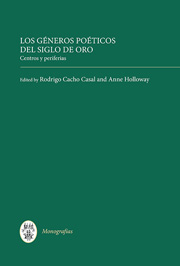Book contents
- Frontmatter
- Dedication
- Contents
- Índice de ilustrationes
- Índice de colaboradores
- Introducción: Géneros, centros, periferias
- I DEL CENTRO A LA PERIFERIA: GÉNEROS Y CONTRAGÉNEROS
- II AGUDEZA, RETÓRICA Y EMBLEMÁTICA
- III GÓNGORA Y SU ESTELA
- IV POESÍA COLONIAL: EL NUEVO CENTRO
- V LA POESÍA Y SUS MARCOS: MANUSCRITOS, ANTOLOGÍAS, MISCELÁNEAS
- 14 Pautas y razones de las formas de transmisión de la poesía en el Siglo de Oro: el caso de Sevilla
- 15 Conceptualización de la naturaleza creativa: Góngora y Luis Martín de la Plaza en Flores de poetas ilustres (1605)
- 16 Imitaciones, integraciones y academias: estrategias poéticas en el Pusílipo de Cristóbal Suárez de Figueroa
- Bibliografía
- Índice onomástico
16 - Imitaciones, integraciones y academias: estrategias poéticas en el Pusílipo de Cristóbal Suárez de Figueroa
from V - LA POESÍA Y SUS MARCOS: MANUSCRITOS, ANTOLOGÍAS, MISCELÁNEAS
Published online by Cambridge University Press: 05 September 2013
- Frontmatter
- Dedication
- Contents
- Índice de ilustrationes
- Índice de colaboradores
- Introducción: Géneros, centros, periferias
- I DEL CENTRO A LA PERIFERIA: GÉNEROS Y CONTRAGÉNEROS
- II AGUDEZA, RETÓRICA Y EMBLEMÁTICA
- III GÓNGORA Y SU ESTELA
- IV POESÍA COLONIAL: EL NUEVO CENTRO
- V LA POESÍA Y SUS MARCOS: MANUSCRITOS, ANTOLOGÍAS, MISCELÁNEAS
- 14 Pautas y razones de las formas de transmisión de la poesía en el Siglo de Oro: el caso de Sevilla
- 15 Conceptualización de la naturaleza creativa: Góngora y Luis Martín de la Plaza en Flores de poetas ilustres (1605)
- 16 Imitaciones, integraciones y academias: estrategias poéticas en el Pusílipo de Cristóbal Suárez de Figueroa
- Bibliografía
- Índice onomástico
Summary
Resta ahora interpolar los versos con algunas prosas …
Con esta mezcla, con este entreverado, se disimula no
poco aquella mala calidad de rimas solas.
(Alivio II de El pasajero [1617], Cristóbal Suárez de Figueroa)El importante papel que desempeñan la poesía y otras formas de literatura imaginativa en el género aurisecular de la miscelánea no ha merecido hasta ahora un estudio detallado o, por mejor decir, coherente. Dos razones se sugieren para justificar esta omisión: la amplia indefinición que ha caracterizado el debate sobre este género divulgativo —a partir de la misma terminología crítica que empleamos para tratar estas obras— así como la carencia de un examen de la tradición que abarque tanto el siglo XVI como el XVII, los periodos aproximados de las llamadas misceláneas renacentistas y barrocas. La miscelánea nace en España en 1540, con la publicación de la Silva de varia lección de Pedro Mexía, quien adapta en lengua vulgar el método de los humanistas neolatinos de proveer informaciones breves, eruditas y sumamente heterogéneas en un único volumen; el objetivo principal es el de transmitir lo que el autor ha podido extraer de sus propias lecturas, ahorrando un gran esfuerzo a sus lectores. El libro de Mexía consigue un fenomenal éxito editorial, cumpliendo perfectamente el deseo expresado en el prólogo de dar materias de lectura a todo tipo de gente, y aparecen a lo largo de los cien años siguientes numerosas obras que imitan el espíritu de la Silva.
- Type
- Chapter
- Information
- Los géneros poéticos del Siglo de OroCentros y periferias, pp. 313 - 332Publisher: Boydell & BrewerPrint publication year: 2013



